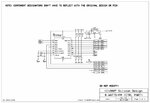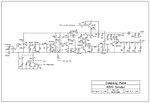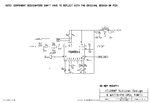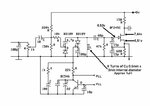Imalu3055
Member level 1
Hello!
I have bought RDVV 5w Moutoulos PCB - GP Electronics (from Greece) on eBay. I used the components exactly indicated and checked before soldering. When I connected the 12 volts the PIC worked correctly but THE OSCILLATOR DID NOT WORK!
I checked again and noticed no errors. I replaced the varicaps with a 22pF capacitor and the oscillator did not start. I replaced the coil L of the Colpits oscillator with others recommended by the author, who does not respond any more, the original is: 8 turns of copper of 0.5mm and 3mm internal diameter (not working), 9 turns of copper of 0.5mm and 3mm inner diameter and 4 turns of 1mm and 6mm inner diameter copper and it didn't work. I replaced the 680 ohm resistor from JFET J310 (they recommend replacing the BF245 with J310) source to GND with a 47uH choke, it didn't work either. I replaced the JFET and it didn't work either.
After several attempts to communicate with the author of the printed plate, who manufactures and sells FM transmitters, he responded evasively and did not provide any information. I appeal to the knowledge of the members of this forum.
Thanks a lot.
 Claudio Denegri
Claudio Denegri
I have bought RDVV 5w Moutoulos PCB - GP Electronics (from Greece) on eBay. I used the components exactly indicated and checked before soldering. When I connected the 12 volts the PIC worked correctly but THE OSCILLATOR DID NOT WORK!
I checked again and noticed no errors. I replaced the varicaps with a 22pF capacitor and the oscillator did not start. I replaced the coil L of the Colpits oscillator with others recommended by the author, who does not respond any more, the original is: 8 turns of copper of 0.5mm and 3mm internal diameter (not working), 9 turns of copper of 0.5mm and 3mm inner diameter and 4 turns of 1mm and 6mm inner diameter copper and it didn't work. I replaced the 680 ohm resistor from JFET J310 (they recommend replacing the BF245 with J310) source to GND with a 47uH choke, it didn't work either. I replaced the JFET and it didn't work either.
After several attempts to communicate with the author of the printed plate, who manufactures and sells FM transmitters, he responded evasively and did not provide any information. I appeal to the knowledge of the members of this forum.
Thanks a lot.











